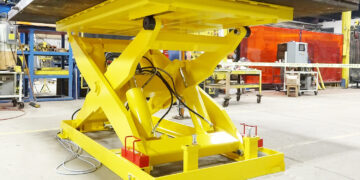5 Safety Considerations When Using a Scissor Lift

Scissor lifts are essential in many industries, ranging from construction to maintenance and the warehousing and logistics sector. These versatile machines allow workers to reach elevated areas and work at heights safely with ease. However, there are a few upfront considerations to bear in mind if you wish to enhance safety when operating a scissor lift. This article will discuss five essential safety considerations when using scissor lifts to ensure that both the operator and those working nearby remain safe at all times.
Proper Training & Certification
Before operating a scissor lift, the operator must receive appropriate training and hold a valid certification. This training should cover essential aspects such as the correct operation of the equipment, understanding the lift’s limitations, and identifying potential hazards before operation. Ensuring that the operator is well-trained and certified will not only help prevent accidents, but also ensure compliance with all laws and regulations surrounding the use of this type of equipment.
Pre-Operation Inspection
Before using a scissor lift, it’s vital to conduct a thorough pre-operation inspection. This inspection should include checking the equipment’s overall condition, ensuring that all safety features are functioning correctly and that there are no visible signs of damage or wear. It’s also crucial to inspect the work area for potential hazards, such as uneven surfaces, overhead obstructions and nearby power lines. By conducting a comprehensive pre-operation inspection, you can address any potential issues before they become serious safety hazards.
Adherence to Load Capacity Limits
One of the most critical safety considerations when using a scissor lift is adhering to the specified load capacity limits. Overloading the lift can lead to instability, causing the equipment to tip over or collapse. Always check the lift’s load capacity, which should be clearly stated on the equipment. Make sure that the combined weight of the operator, tools and materials never exceeds this limit.
Use of Fall Protection Equipment
Although scissor lifts are designed with guardrails to prevent falls, it’s still essential for operators to use appropriate fall protection equipment, such as a safety harness and lanyard. This equipment should be securely anchored to the lift, ensuring that the operator remains protected if a fall occurs. It’s crucial to regularly inspect fall protection gear for signs of wear or damage and replace any compromised equipment immediately before using it again.
Safe Operation Practices
There are some basic universal safe operation practices that should be followed when using a scissor lift. Some essential guidelines include:
- Always operate the lift on a stable and level surface
- Avoid using the lift in adverse weather conditions, such as high winds or heavy rain which can compromise stability
- Do not exceed the lift’s maximum height or reach limitations
- Be cautious when working near power lines, maintaining a safe distance to prevent electrocution risks
- Never attempt to move the lift while it’s elevated, as this can cause instability and increase the risk of tipping over
By following these safety considerations, you can minimise the risks associated with using a scissor lift and ensure a safe working environment.











